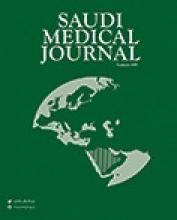Abstract
OBJECTIVE: To evaluate the pathological patterns associated with male infertility in Kuwait and to characterize treatment outcome after varicocele repair using percutaneous varicocele embolization.
METHODS: We carried out a prospective study of 64 infertile men in Kuwait between 2001 and 2005. All patients included had proven non-obstructive azoospermia or oligospermia (sperm count <20 million/ml). All patients underwent ultrasonographic evaluation of the scrotum. Fine needle aspiration of the testes was performed on all azoospermic patients.
RESULTS: A total of 24 (38%) patients were azoospermic while 40 (62%) were oligospermic. Sertoli- cell-only pattern was the most common cytopathology associated with primary testicular failure. Among the oligospermic patients, 50% had small to moderate varicocele. Spermatic vein embolization resulted in a significant rise in the mean sperm count from 10.6 ± 3.8 million/ml to 30.2 ± 6.8 million/ml (p<0.05) in 5 treated oligospermic patients, followed by spontaneous pregnancy in 2 couples. No effect was seen on azoospermic patients.
CONCLUSION: From an etiological point of view, we believe that the high incidence of Sertoli cell-only-syndrome among nationals and residents of a country that underwent a major environmental insult strengthens the chances of an environmental role in the development of this syndrome. From a management point of view, in cultures where in vitro fertilization is either still not widely acceptable or is unaffordable, oligospermia with clinical or subclinical varicocele deserves a trial of a low risk, out patient procedure, namely, spermatic vein embolization that could improve fertility.
- Copyright: © Saudi Medical Journal
This is an open-access article distributed under the terms of the Creative Commons Attribution-Noncommercial-Share Alike 3.0 Unported, which permits unrestricted use, distribution, and reproduction in any medium, provided the original work is properly cited.






